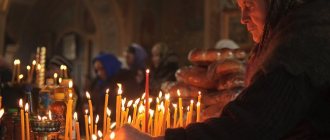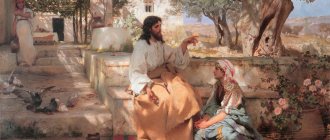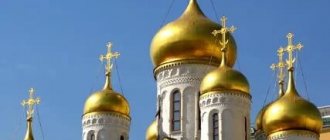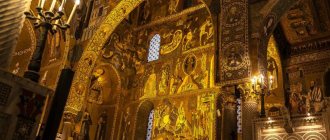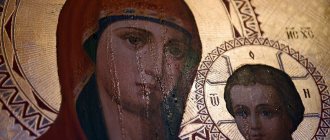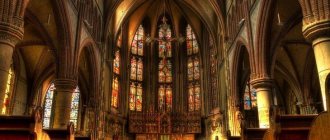What is an altar in a church?
Its name means “exalted altar” in Latin. This is perhaps the oldest definition of place:
- Old Testament texts understand by it a special exaltation for making sacrifices to the True God;
- in the Christian West, the word “altar” during the time of the Ancient Church denoted the actual place where the Eucharist was celebrated, that is, what in the Russian tradition is called the throne;
- Slavic liturgical texts generally refer to this as the entire part of the church where the Sacrament of the Eucharist is celebrated.
Sacrifice of Cain and Abel
Story
For many centuries, people, trying to return the Kingdom of Heaven, lost after the fall of the first people Adam and Eve, built temples, and in them altars, as they thought, to the gods, but in reality - to lower spiritual entities, fallen angels. Although the man’s impulse was fundamentally noble, the sinful damage to his spiritual vision led to the fact that the words of the Apostle came true over many:
“I don’t understand what I’m doing: because I don’t do what I want, and what I hate, I do.”
(Rom.7:15).
Serving the True, Living God was performed by only one people - the Jews.
Among the ancient Jews
For the first time, the “Holy of Holies,” the place of the real presence of God, appeared in the Tabernacle, a camp temple built by the prophet Moses immediately after the Jews left Egypt. In this specially constructed tent there was a place hidden from people by a curtain. Here was the Ark of the Covenant, and in it were stone tablets with the Commandments, the flourishing rod of the high priest Aaron , which signified his Divine election, and finally, a vessel with heavenly food, manna, which the Jews ate for 40 years in the desert. On this spot. The Lord mysteriously revealed His will to Moses.
The Ark later ended up in the First Temple of Jerusalem, also behind the veil. There was also a Holy of Holies in the second temple, built after the Babylonian captivity of the Jews.
By that time, the Ark had already been lost, but God was still with His chosen people - which means there was a Holy of Holies - even if now it was an empty hall with an area of 10x10 m. Once a year, the high priest came here with sacrificial blood, a prayer for the sins of the people .
Ark of the Covenant. Artistic reconstruction of the 19th century incorporating stylistic elements from the Renaissance
Temples of the first centuries of the Church
At the moment of the Lord's death, the curtain that hid the sanctuary was torn in two, revealing the sacred place. This was a clear sign that the barrier between the Creator and man had been destroyed. Therefore, the first Christian churches did not have any curtains or other barriers that would separate the place where the sacrament was performed from the rest of the church space.
But several centuries have passed. The ardent faith began to weaken, and after the end of three hundred years of persecution, people who did not have the spiritual experience of the first Christians flocked to the Church. According to legend, St. Basil the Great , bishop of the city of Caesarea in the Cappadocia region, once saw how the deacon who served him looked at a woman present at the service - immediately the Holy Spirit departed from the servants. They say it is St. Basil first introduced a curtain that separated the most sacred place of the temple.
And many centuries later, priest Pavel Florensky will say:
“The limitation of the altar is necessary so that it does not turn out to be nothing for us.”
Altar diagram
Scheme of the arrangement of the Orthodox altar
Appearance of the Altar in the Second Temple [↑]
1. Foundation ( "yesod"
). From the west and north, the foot of the altar was surrounded by timber. The width of this beam was one cubit (half a meter), and it extended another cubit to the east and south.
2. Two holes for drainage of blood remaining after sprinkling.
3. A red line encircling the altar in the middle and dividing it into two parts. The blood of some victims was sprinkled on the upper part, others on the lower part.
4. Decorative cladding one cubit wide, located above the red demarcation line.
5. Cornice around the altar ( “sovev”
). It extended out to one cubit, and the kohanim moved along it to the corners of the altar to sprinkle with sacrificial blood.
6. Main ramp ( "kevesh"
).
7. An auxiliary ramp extending from the main one to the right. It led to the cornice on which the kohanim stood, splashing sacrificial blood.
8. Auxiliary ramp leading to the base. The kohanim descended along it to the base of the altar to drain the remaining blood after sprinkling into the drainage holes.
9. A hatch at the top of the main ramp for cleaning the inside of the altar.
10. A window in the left wall of the main ramp, where the kohanim put sacrificial birds deemed unfit. These birds were then taken out and burned.
11. Four corner protrusions. These projections were hollow and open at the top. The Kohens splashed the blood of their victims on them.
12. Passage for Kohanim ( "karkov"
). The Kohanim walked along a one-cubit-wide encircling path that had a small depression.
13, 14, 15 - woodpiles.
16. Main pile of ash.
17. Two drainage holes for sacrificial libations - one for wine (used daily), the other for water (used on the “water libation festival” of Sukkot).
Altar structure
From this, the most important part, the construction of any temple begins. Architects say that the shape, decor, even the radius of the altar and the main dome of ancient churches most often coincide. This is not accidental: after all, the temple is a single ensemble, Heaven on earth, and its heart is where the throne is.
Where is?
As you approach the temple, you will notice one or more semicircular projections. They are called apses, and are made for the altar. From them you can see how many altars the temple has - for example, a three-altared one usually includes three apses - a central, larger one, and two smaller ones on the sides. Inside the church, the location of the altar is also easy to determine by the iconostasis - several rows of holy images. They hide a sacred place. The so-called “royal doors” lead inside, and two others – northern and southern, called deacon’s.
Why in the east?
As a rule, temples are oriented in such a way that the first rays of the rising sun fall on the throne. The tradition is usually associated with the fact that in the east, according to the Book of Genesis (Genesis 2:8), Paradise is located:
“And the Lord God planted a garden in Eden in the east, and there he placed the man whom he had created.”
However, the tradition did not develop immediately, not everywhere:
- Thus, the Roman Cathedral of St. Petra, built on the site of a 4th- century basilica, faces west; Pope Benedict XVI, in his book “Theology of the Liturgy,” explains precisely the Catholic tradition when the priest during Mass prays “versus populum” (“facing the people”), that is, to the east, and not to the throne; the very orientation of the cathedral is usually explained by the specifics of the terrain, and, apparently, by the fact that the tradition of praying to the east developed from the first centuries, but the rule of the same orientation of the altar appeared later;
- “violations” of the currently accepted custom also exist on the territory of Russia, where churches of the first centuries after the Baptism of Rus have been preserved; for example, the churches of Pskov, as well as its immediate surroundings until the 14th century. were turned not to the east, but towards the sacred heart of the city - the Kremlin, where the Trinity Cathedral, founded by Princess Olga, stands; many of these churches have survived to this day and are active, although their location does not coincide with the traditional one.
The current church of St. Nicholas near Pskov. Her altar is not oriented to the east. Photo by the author of the article, July 2011 9.30 am, you can see from the shadows where the sun is.
What does the sacred altar look like: description
The peculiarity of this part of the temple is that it is at some elevation in relation to the nave (where worshipers gather) and the vestibule (the western part of the church).
What's there
Now it's common here:
- the throne is a mandatory accessory of the temple from the first centuries of the Church;
- altar;
- the bishop's chair, which is located on the so-called High Place - opposite the throne at the very eastern walls;
- sacristy.
Throne
This is part of the altar, known since the times of the Ancient Church. Initially, the sacrament of the Eucharist was performed directly on the stone tomb of the martyr, which served as a throne. This is where the custom of later churches came from to have a particle of the relics of saints in the altar. It was finally established in the 8th century.
Throne and canopy over the throne of the Assumption Cathedral of the Moscow Kremlin
The relics are also enclosed in a special plate located on the throne, in Greek called “antimens” (the word literally means “instead of the throne”). On such a board, the liturgy can be performed even outside the church.
There is evidence that during the persecutions of the Soviet years, imprisoned priests more than once served the liturgy literally on the relics - on the chest of a martyr dying of hunger, overwork. Here is the story of a witness to such services, Archimandrite Tavrion :
“How did they serve without an antimension, without a throne? One priest lay down, and the rest served on his chest. Instead of prosphora - bread. The Lord said at the Last Supper that the bread is transformed into His Body. And instead of wine - water. In Cana of Galilee, the Lord turned water into wine. And we all took communion. They were happy and cheerful! With God there is no loss anywhere!”
Nowadays the throne can be made of wood or stone. The wooden throne is covered with brocade vestments. A stone vestment may not have fabric: vestments for it are often made of expensive metal, decorated with precious stones.
Throne
The throne of the Church of Hagia Sophia in Constantinople had such vestments. And its top board was made of pure gold interspersed with precious stones.
On top of the vestments of the throne are placed:
- antimins;
- Gospel;
- cross.
In addition, on the throne there is a Tabernacle and a lamp.
Altar
Now this is the name given to the northern part of the altar space, as well as the table itself, on which the sacred vessels for performing the main Sacrament are located. Here, before the start of the liturgy (during the reading of the Hours), the priest performs Proskomedia, preparing sacrificial bread for the Eucharist.
This arrangement of the altar is a later one, established as a widespread custom no earlier than the 6th-8th centuries.
Interesting fact
The modern liturgist,
R. Taft , an expert in Byzantine worship, managed to establish that in the church of St.
Sophia of Constantinople, the most famous cathedral of the Christian world, liturgical vessels were located not only outside the temple itself, where there was a special room called skevophilakia. When the time came for the Sacrament, a procession of clergy was sent from the altar. Having taken the vessels, the priests and deacons returned just as solemnly. At the same time, the believers asked their prayers for themselves, to which the priests replied: “May the Lord remember you all in His Kingdom!” This is how the custom now called the Great Entrance originally arose. Subsequently, it received a theological interpretation, symbolizing the procession of Christ to Calvary.
Department
The exact name of this part is “ἡ ἄνω καθέδρα”, or “upper pulpit”. In Slavic it is also called the Mountain Place. There is a special chair here, usually richly decorated. This is the place of the Lord, seated among His disciples. If the church is a parish church, a lamp is always burning on the High Place, signifying the invisible presence of Jesus Christ. In the cathedral it is occupied by the bishop during services.
Quite often the Mountain Place is located quite high. Initially, when the altar had a low barrier, it was more convenient for the bishop to deliver sermons from the High Place, rising above the space of the temple. Subsequently, the symbolism of the steps leading upward was rethought: now it is more a symbol of the throne of God. When the bishop ascends to the pulpit, his exclamation “Peace to all” clearly recalls Christ’s last blessing to the disciples before His Ascension.
Near the High Place there are also benches for the clergy, where they sit during some moments of the service.
High place in the altar
Sacristy
This is the southern part, otherwise called the diakonnik. The vestments of priests and other ministers, as well as liturgical books and other items are stored here.
At least until the 16th century. in Rus', the sacristy was also called “kuteinik”, from the name of the traditional dish served at funerals. After all, according to the ancient Russian tradition, it was here that parishioners brought candles and notes about the repose of their relatives. They also carried food that is now customary to be left on the funeral table.
Interesting fact
Only in 1551 did the Council of the Hundred Heads prohibit the bringing into the altar of anything other than bread and wine used during divine services. However, for a very long time the tradition of burying benefactors and noble parishioners was preserved here.
Thus, in the sacristy of the Archangel Cathedral of the Moscow Kremlin there is the grave of Ivan IV , as well as his sons Ivan and Theodore.
Rise in front of the altar
Firstly, this is the so-called soleya; it stretches across the entire width of the iconostasis. Initially, it was needed so that the service could be better seen and heard by all parishioners, even those standing far away. The center of the solea is a semicircular protrusion exactly in front of the royal doors, called the pulpit. Scripture is usually read from it and sermons are delivered.
Interesting fact
Historically, the pulpit did not always have a low height - in large cathedrals it could rise even to several meters, and look like a small tower. For example, above the high pulpit of the Church of St. Sophia of Constantinople had a canopy with 8 columns, and a high staircase led up. According to the recollections of contemporaries, its construction took the annual budget of one of the Byzantine provinces - Egypt.
Such pulpits, of course, were not protrusions on the sole: they were placed in the center of the temple. Antiphons were sung from them and sermons were read. The royal wedding took place on the pulpit.
What did the altar look like? [↑]
The Torah gives a detailed description of the altar that stood in the courtyard of the Mishkan, after which the altars in the First and Second Temples were built: “And you shall make an altar of shittim wood.”
The length is five cubits and the width is five cubits; the altar will be square, and its height will be three cubits.
And make its horns on its four corners; from him (himself) will be his horns; and cover it with brass.” And thou shalt make his pots for (removing) the ashes from him, and his shovels, and his sprinklers, and his forks, and his braziers; make all its accessories from copper. And make a mesh grate for it (of) copper... And place it under the girdling of the altar from below, and the grate will (reach) half of the altar. Make it hollow, plank... ( Shemot 27:1-8
).
Rashi provides a commentary on this passage. The words “its height is three cubits” should be understood as the height from the edge of the girdle to the top, and the total height of the altar is 10 cubits. The lattice is a kind of vestment, perforated like a net. Belt ( "karkov"
) - a circular recess one cubit wide on the wall (of the altar) for decoration. There was also another girdling - a recess running along the perimeter of the roof, from one horn to the other, along which the clergy walked. Its width is one cubit. The upper border of the lattice divided the altar into two halves. This was necessary to distinguish between the “upper blood” and the “lower blood” (the upper part of the altar - the horn - was sprinkled with the blood of the atonement sacrifice, and the lower part with the blood of the peace offering, burnt offering and guilt offering). And similar to this, a band of red thread in the middle was made for the altar in the Temple.
Braziers (trays) are a special container for taking coals and transferring them to the altar for burning incense, located inside the Temple.
The Kohens climbed up along gentle footbridges called kevesh.
.
Out of respect for the altar, it was forbidden to climb the steps, as the Almighty said to Moshe: “And do not ascend the steps to My altar, lest your nakedness be revealed therein” ( Shemot 20:23
).
The altars in the First and Second Temples differed from the altar of the Mishkan, first of all, in their size. With the same height, their base area was much larger. Thus, the outer altar built in the Second Temple by the Maccabees measured 32 by 32 cubits (for a detailed description of this altar, see the website in the Mishnah, in Tractate Midot
).
What is the difference between Catholic and Orthodox?
First of all, by the fact that the altar does not mean space, but only a table for celebrating the Eucharist. It is not separated by an iconostasis; believers see all moments of the service.
Another difference is that the Tabernacle is usually located in a special cabinet on the wall behind the altar or nearby. You can recognize it by its special design or ornament. Sometimes he is styled as a star. A Catholic entering a church first of all bends one knee, making the sign of the cross with a bow to the Holy Gifts.
Altar of the Church of the Madeleine in Paris
Symbolism
The altar symbolizes the Kingdom of Heaven, the place of God. It also reminds us of the Zion Upper Room, where the Lord Jesus Christ celebrated the Last Supper. We partake of this Supper at every Divine Liturgy, since time does not exist in the Heavenly World. Orthodox Christians believe that the altar is the place of special Divine grace. In the altar of the temple there is always an angel given to it during consecration. If the temple is destroyed, the angel will remain in his place until the Second Coming and the end of the visible world.
Why aren't women allowed in?
From the Old Testament names there is a ban on bringing blood other than sacrificial blood into the Holy of Holies. Since the essence of the Christian liturgy is the Sacrifice of the Body and Blood of the Son of God, this prohibition continues to apply. According to Rule 44 of the Council of Laodicea (360), women are prohibited from entering the altar “for reasons of involuntary menstruation.” However, sometimes being here to help during worship is possible. Usually, with a special blessing, the following are allowed:
- elderly nuns - this happens especially often in monasteries;
- During the persecutions of the Soviet years, older parishioners also sometimes helped the priests of parish churches.
There is such a concept: “a candle for the altar” - what is the meaning?
This is a donation to the temple, which is made by the parishioner whenever possible. There are candles burning on the throne, standing on the altar. In addition, priests stand with candles during the All-Night Vigil when the Gospel is read. Such candles are either purchased by the temple or donated by zealous parishioners.
The Throne of God and Golgotha, the place where Angels concelebrate with earthly clergy - this is the heart of any Orthodox church, even the most modest one.
Natalia Sazonova
